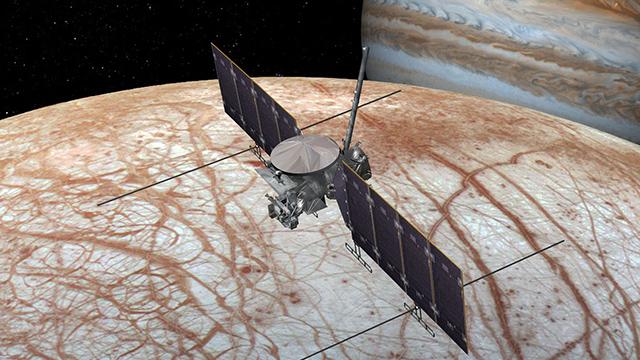NASA explores the interior of Jupit...
08
03
NASA explores the interior of Jupiter's moon Europa "Europa Clipper" assembly start
Jupiter's moon Europa imaged by the Galileo spacecraft

Jupiter's moon Europa is one of the "Galilean moons" (Io, Europa, Ganymede, Callisto) discovered by Galileo Galilei in the 17th century. The surface of Europa is covered with ice, but it is thought that there is a vast internal ocean sandwiched between the ice shell and the rock layer inside, where life was born and inhabited. It is attracting attention as it may exist. Currently, the National Aeronautics and Space Administration (NASA) is planning a mission to explore Europa with the unmanned spacecraft "Europa Clipper." Europa Clipper orbits Jupiter, approaches Europa 40 to 50 times, passes over it and makes observations, and is planned to eventually cover the entirety of Europa. NASA's Jet Propulsion Laboratory (JPL) reported on March 3 local time that assembly of the spacecraft has finally begun for a planned launch in 2024.
An artist's impression of the Europa Clipper spacecraft observing Jupiter's moon Europa.
Europa Clipper is equipped with two foldable solar arrays in its main propulsion module, which is 3m high. A total of 10 scientific observation instruments are installed, including cameras, spectroscopes, radars, and magnetometers, and observation data is transmitted to the earth using a high-gain antenna with a diameter of 3m. According to JPL, mechanical parts and scientific equipment are currently arriving at JPL from all over the United States and Europe, and it is expected that most of the hardware will be assembled by the end of 2022. The Europa-UVS ultraviolet spectrometer developed by the Southwest Research Institute (SwRI) has already arrived at JPL's clean room where assembly will take place. Europa-UVS is a scientific instrument for spectroscopic observations (*) of Europa's rarefied atmosphere and surface using ultraviolet wavelengths. It is hoped that we will be able to obtain observational data that will lead to answers to questions such as whether water is erupting from the surface of Europa, and what other substances exist on the surface of Europa other than ice. *…Observation method to obtain the target spectrum (electromagnetic wave strength for each wavelength).The propulsion module and high-gain antenna will be sent to JPL soon. The propulsion module, which is the core of the spacecraft, and the high-gain antenna used for communication with the earth were developed by the Johns Hopkins University Applied Physics Laboratory (APL).
Last Update: sorae Space Portal Site

![[Kill personally developed games] Top class in app history! Too beautiful water puzzle "a [Q] ua" | Famitsu App for smartphone game information [Kill personally developed games] Top class in app history! Too beautiful water puzzle "a [Q] ua" | Famitsu App for smartphone game information](https://website-google-hk.oss-cn-hongkong.aliyuncs.com/drawing/article_results_7/2022/3/3/66755df992ff2d2b1e1ab43844ef9f88_0.jpeg)





![[Latest in 2021] 10 recommended seat covers for cars!If you want to improve the texture and functionality of the car, choose the mounting type and material. [Latest in 2021] 10 recommended seat covers for cars!If you want to improve the texture and functionality of the car, choose the mounting type and material.](https://website-google-hk.oss-cn-hongkong.aliyuncs.com/drawing/article_results_7/2022/3/3/e5b44589e77141f3a633189165fb6f60_0.jpeg)